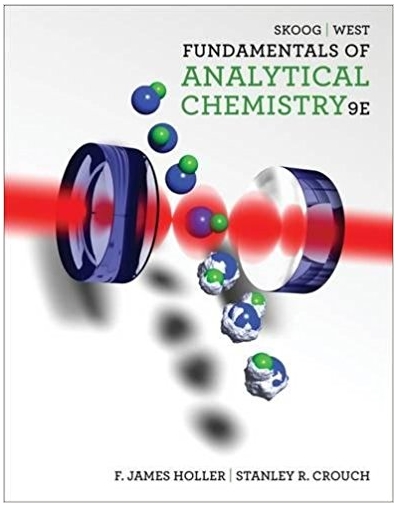You need to choose between determining an analyte by measuring an electrode potential or by performing a
Question:
(a) The absolute amount of the analyte to a few parts per thousand.
(b) The activity of the analyte.
Fantastic news! We've Found the answer you've been seeking!
Step by Step Answer:
Answer rating: 42% (7 reviews)
a A titration is generally more accurate than measurement...View the full answer

Answered By

Utsab mitra
I have the expertise to deliver these subjects to college and higher-level students. The services would involve only solving assignments, homework help, and others.
I have experience in delivering these subjects for the last 6 years on a freelancing basis in different companies around the globe. I am CMA certified and CGMA UK. I have professional experience of 18 years in the industry involved in the manufacturing company and IT implementation experience of over 12 years.
I have delivered this help to students effortlessly, which is essential to give the students a good grade in their studies.
3.50+
2+ Reviews
10+ Question Solved
Related Book For 

Fundamentals of Analytical Chemistry
ISBN: 978-0495558286
9th edition
Authors: Douglas A. Skoog, Donald M. West, F. James Holler, Stanley R. Crouch
Question Posted:
Students also viewed these Chemical Engineering questions
-
Equation 23-3 gives the mass of analyte extracted into a solid-phase microextraction fiber as a function of the partition coefficient between the fiber coating and the solution. (a) A commercial...
-
What is the dc impedance of the electrode, assuming that it behaves as an ideal capacitor? (a) 0; (b) Infinite; (c) 2 10 4 ; (d) 2 10 6 . An individual cell such as an egg cell (an ovum, produced...
-
If the electrode oscillates between two points 20 mm apart at a frequency of (5000/)Hz, what is the electrodes impedance? (a) 0; (b) Infinite; (c) 2 10 4 ; (d) 2 10 6 . An individual cell such as...
-
Understanding the history and background of your company gives you valuable insights as to what to do and what not to do going forward. A brief written summary of the background and history of the...
-
Peter is a professor of mathematics at State University. His lifetime avocation has been sailing, and he owns an oceangoing sailing vessel. He plans to retire in five years and spend the remainder of...
-
The Texago Corporation has four oil fields, four refineries, and four distribution centers. A major strike involving the transportation industries now has sharply curtailed Texagos capacity to ship...
-
Given that charge separation increases the electric potential energy of a system, what can you conclude about the criteria for keeping a system of positively and negatively charged particles in...
-
The Personnel Department at Drumm Corporation is centralized and provides services to the two operating units: Illinois and Ohio. The Illinois unit is the original unit of Drumm and is well...
-
What two different types of firmware may be used on motherboards? a. POST b. UEFI c. CMOS d. BIOS
-
The Best Manufacturing Company is considering a new investment. Financial projections for the investment are tabulated here. The corporate tax rate is 34 percent. Assume all sales revenue is received...
-
The Na+ concentration of a solution was determined by measurements with a sodium ion-selective electrode. The electrode system developed a potential of -0.2462 V when immersed in 10.0 mL of the...
-
Describe the source of pH dependence in a glass membrane electrode.
-
a. Find the slope of the line from the origin to the midpoint P of side AB in the triangle in the accompanying figure (a, b > 0). b. When is OP perpendicular to AB? y B(0, b) P A(a,0) X
-
Classify the following economic variables as procyclical or countercyclical and as leading, lagging, or coincident: real consumer spending, real investment spending, unemployment, inflation, S&P 500...
-
Find the following F 1;2; values. (a) v = 10, V2 = 10, and = .05 Vi (b) v = 15, v = (c) v = 12, v = V2 (d) v = 20, V2 = 3, and x = .01 15, and x = .025 10, and x = .005
-
A credit manager at the Bargain Basement Department Store is interested in the proportion of customers who pay their credit card balances in full each month. A random sample of 200 customers...
-
This industry dates back thousands of years, is visible in TV news, is global in nature, and has annual sales of $100 billion. Yet participants do not even agree on how to label it, and most...
-
A quality control engineer believes that the life of light bulbs for his company is normally distributed with a standard deviation of 100 h. A random sample of 10 light bulbs gives the following...
-
How might supercomputers be employed in your current or future career field?
-
Which of the following raises the credibility of areport? Which of the following raises the credibility of a report? Multiple Choice avoiding predictions avoiding the use of cause-effect statements...
-
A temperature scale that never quite caught on was formulated by the Austrian chemist Johann Sebastian Farblunget. The reference points on this scale were 0FB, the temperature below which Farblungets...
-
A Thermocouple is a temperature-measurement device that consists of two dissimilar metal wires joined at one end. An oversimplified diagram follows. A voltage generated at the metal junctions is read...
-
A thermostat control with dial markings from 0 to 100 is used to regulate the temperature of an oil bath. A calibration plot on logarithmic coordinates of the temperature, T(?F) versus the dial...
-
Johnny's Lawn Service camed $200,000 of service revenues for 2020. $190,000 was collected in cash and $10,000 remains in Accounts Receivable as of 12/31/20. S155,000 of expense was incurred during...
-
Company BW has $500,000 loan outstanding. The annual loan interest rate is 6% with monthly compounding (meaning BW is making monthly payments). Find the annual after-tax cost of debt for the loan.
-
The hierarchical system of classification is intended to be a map of evolution. Explain this statement. What is implied about species that occur on the same branch of a phylogenetic tree?

Study smarter with the SolutionInn App


